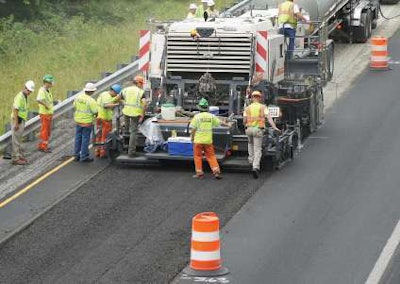 Crews cold-in-place recycle a lane of I-81 in Virginia.
Crews cold-in-place recycle a lane of I-81 in Virginia.A recent paving project on Route 43 in Williamstown, Mass., might have residents wondering if it’s really finished, according to a report by iBerkshires.com. The cold-in-place recycling technique the city is using leaves the road looking unfinished for a little while.
Town Manager Jason Hoch told the news agency that, “At the end of the project, it will look and feel like any other road, but there’s this sort of interim phase — it’s that ‘near-pavement’ look. I learned in the past, the first time we did this process at one of the towns I was in in New Hampshire, we got a lot of feedback from people saying, ‘Boy, you guys did a horrible job paving this road.’ We had to say, ‘No, no, no. We’re not done yet.'”
Work began the week of August 15, 2016 when crews began stripping the road. The pavement is removed, crushed, mixed with an emulsifier, and then laid back down, which creates the not-quite-finished look. Once completed, a finish course of blacktop will be laid on top.
“We’re all trained to see the gravel and then see the pretty black surface,” Hoch told the news agency. “We’re not used to this interim step that looks like you did a really bad paving job and should get your money back.”
One advantage of the cold-in-place recycling technique is that it reuses 85 percent of the road material at the job site, Hoch told the news agency. The other advantage is that drivers don’t have to drive on gravel after the road is stripped.
“[In a conventional project], the road is in a less appealing position for a lot longer period of time, that sort of ‘letting the gravel sit there’ sort of thing,” Hoch told the news agency. “There’s enough traffic there that we won’t be subjecting people who use that road on a regular basis, or visitors coming through, to an extended period of gravel.”
Highway Superintendent Chris Lemoine, who had used the technique on Route 22 in Petersburg, New Hampshire, came to Hoch with the suggestion of using the technique earlier in 2016.
“I wouldn’t necessarily make it the full selling point, but we were pleased with the quality of the pavement as well,” Hoch told the news agency. “We found it was a little more durable and a little more elastic than others as well. It was a good resulting product. This may be something we do again in some cases in the future.”
Most of the $768,984 project is being funded by Williamstown’s Chapter 90 allocation from the commonwealth. Approximately $14,400 is coming from local taxes. The project is expected to be finished by the end of August 2016.












